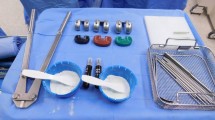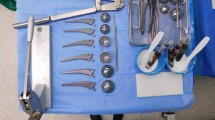Abstract
Objective
Treatment of chronic periprosthetic joint infection of the knee requires the removal of the implant and thorough debridement, with reimplantation in a second stage surgery. Intramedullary spacers can be helpful during the interval between explantation and reimplantation and provide a temporary arthrodesis which fixes the knee in extension preserving leg length and administers local antibiotic therapy.
Indications
Periprosthetic joint infection of the knee with large bony defects and severe infection of the native joint with advanced destruction/infiltration of the cartilage and bone and/or ligament insufficiency.
Contraindications
Suspected antibiotic resistance of the microbiological pathogen to local antibiotic drugs, incompliant patient, and known allergy to bone cement or antibiotic.
Surgical technique
After implant removal, suitable metal rods are coated with antibiotic-loaded bone cement and inserted into the cleaned intramedullary canals of femur and tibia. Rods are joined at the joint line with a connector and joint space is filled with more bone cement to achieve temporary and very stable arthrodesis.
Postoperative management
Partial weight-bearing and no flexion/extension while spacer is in place; second stage reimplantation as soon as infection is controlled.
Results
Complications related to the spacer were rare (5.3%). Reimplantation of an implant was possible in 95 of 113 patients (84%), of those, 23 (20%) received an arthrodesis. Of the 95 patients that were reimplanted, 14 showed signs of recurrent infection. Mean time to last follow-up was 15.6 months post reimplantation. Mean knee pain was 2.9/10; overall function was good; 6 patients had an extension lag; mean total range of motion was 88°.
Zusammenfassung
Zielsetzung
Die Behandlung von chronischen, periprothetischen Infektionen des Kniegelenks bedarf der vollständigen Entfernung des eingebrachten Fremdmaterials und eines radikalen Débridements sowie einer Reimplantation in einem zweiten Eingriff. Intramedulläre Spacer können zwischen den Operationen des zweizeitigen Vorgehens verwendet werden, um eine temporäre Arthrodese zu erreichen, die das Gelenk in Extension fixiert, die Beinlänge erhält und eine lokale Antibiotikafreigabe ermöglicht.
Indikation
Periprothetische Infektionen des Kniegelenks mit großen knöchernen Defekten sowie schwerwiegende, native Gelenkinfektionen mit fortgeschrittener Destruktion/Infiltration des Knorpels und Knochens und/oder einer ligamentären Instabilität.
Kontraindikationen
Vermutete Antibiotikaresistenz des mikrobiologischen Pathogens auf die verwendeten Antibiotika, Incompliance und bekannte Allergie auf Bestandteile des Knochenzements oder Antibiotikums.
Chirurgisches Vorgehen
Nach der vollständigen Entfernung der Implantate werden metallische Stäbe mit Antibiotika-haltigem Knochenzement beschichtet und in den debridierten Markraum des Femurs und der Tibia eingebracht. Die Spacerstäbe werden anschließend auf Höhe der Gelenklinie mit einem Kopplungsmodul verbunden. Anschließend wird der Gelenkraum mit zusätzlichem Antibiotika-haltigem Knochenzement ausgefüllt, um eine temporäre, stabile Arthrodese zu erhalten.
Postoperatives Prozedere
Teilbelastung mit Fixierung in Streckung; zweizeitige Entfernung des Spacers und Reimplantation einer Prothese, sobald die Infektion konsolidiert ist.
Ergebnisse
Komplikation bezogen auf den Spacer traten selten auf (5,3 %). Eine Reimplantation konnte bei 95 von 113 Patienten (84 %) durchgeführt werden. Hiervon erhielten 23 (20 %) eine Arthrodese. Es entwickelten 14 der 95 reimplantierten Patienten eine Rezidivinfektion. Die mittlere Zeit bis zur Nachuntersuchung betrug 15,6 Monate nach der Reimplantation. Der mittlere Knieschmerz war 2,9/10; die globale Funktion war gut, 6 Patienten hatten eine Extensionseinschränkung, der durchschnittliche Bewegungsumfang lag bei 88°.










Similar content being viewed by others
References
Lübbeke A et al (2018) Mapping existing hip and knee replacement registries in Europe. Health Policy 122:548–557
Kurtz SM et al (2010) Prosthetic joint infection risk after TKA in the medicare population. Clin Orthop Relat Res 468:52–56
Cochrane NH et al (2022) Early infection after aseptic revision knee arthroplasty: prevalence and predisposing risk factors. J Arthroplasty 37(6S):S281–S285. https://doi.org/10.1016/j.arth.2021.10.022
Balato G et al (2019) Hip and knee section, prevention, surgical technique: proceedings of international consensus on orthopedic infections. J Arthroplasty 34(2S):S301–S307
Citak M et al (2015) Dynamic versus static cement spacer in periprosthetic knee infection: a meta-analysis. Orthopade 44(8):599–606
Hertzberg-Boelch S et al (2022) PMMA bone cement: antibiotic elution and mechanical properties in the context of clinical use. Biomedicines 10(8):1830
Lunz A et al (2022) Mechanical strength of antibiotic-loaded PMMA spacers in two-stage revision surgery. BMC Musculoskelet Disord 23(1):945
Borsinger T et al (2022) Does time to reimplantation after explant for prosthetic joint infection influence the likelihood of successful outcomes at 2 years? J Arthroplasty 37(6):1173–1179
Barnavon T et al (2022) The use of static spacers in periprosthetic knee infections. In: Longo UG et al (ed) Infection in knee replacement. Springer, Cham
Ding H et al (2017) Comparison of the efficacy of static versus articular spacers in two-stage revision surgery for the treatment of infection following total knee arthroplasty: a meta-analysis. J Orthop Surg Res 12(1):151
Author information
Authors and Affiliations
Corresponding author
Ethics declarations
Conflict of interest
T. M. Randau has received speaker fees and travel cost reimbursement form Peter Brehm GmbH, implantcast GmbH and Heraeus Medical GmbH. M. Jaenisch, S. Ben Amar, M. Babasiz, A. Seuser, H. Kohlhof and D. C. Wirtz declare that they have no competing interests.
For this article no studies with human participants or animals were performed by any of the authors. All studies mentioned were in accordance with the ethical standards indicated in each case.
Additional information

Scan QR code & read article online
Rights and permissions
About this article
Cite this article
Jaenisch, M., Ben Amar, S., Babasiz, M. et al. Temporary arthrodesis through static spacer implantation in two-stage treatment of periprosthetic joint infections of the knee. Oper Orthop Traumatol 35, 170–178 (2023). https://doi.org/10.1007/s00064-023-00809-7
Received:
Revised:
Accepted:
Published:
Issue Date:
DOI: https://doi.org/10.1007/s00064-023-00809-7




